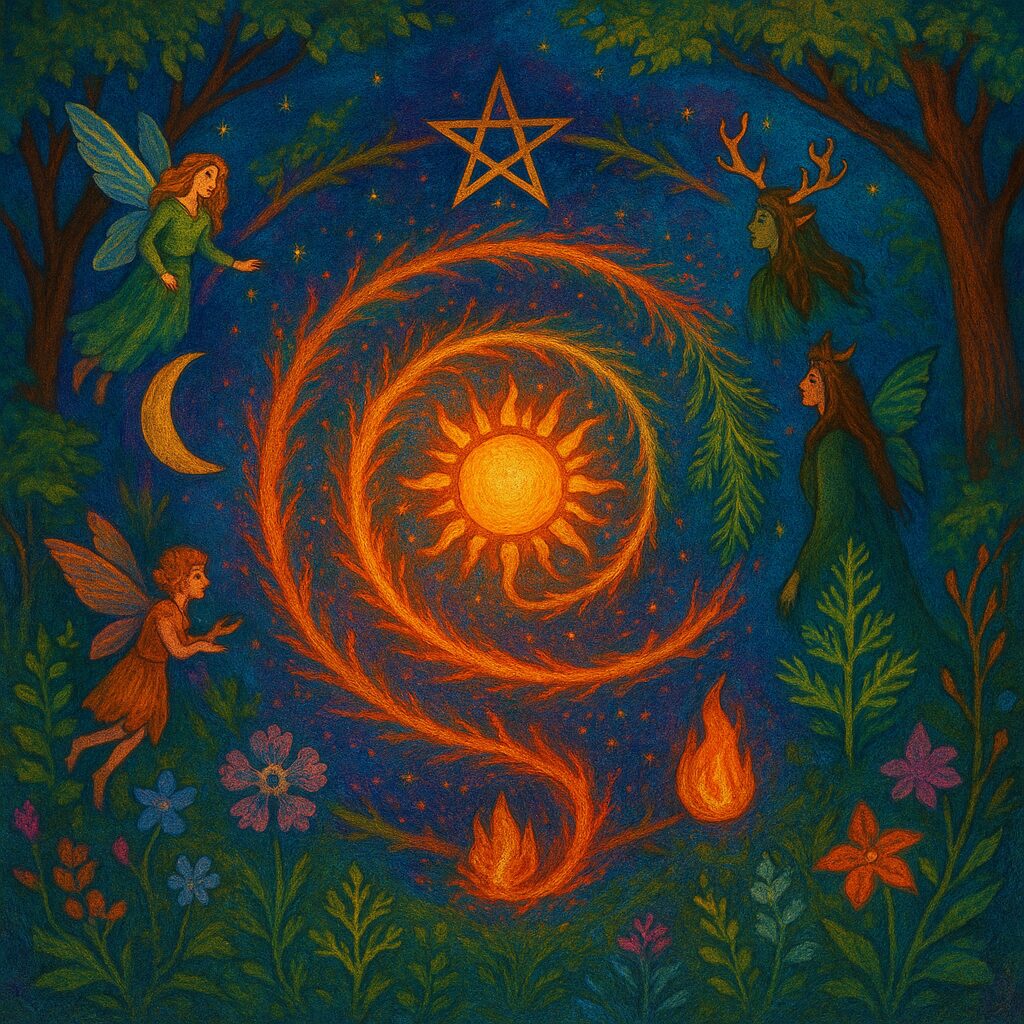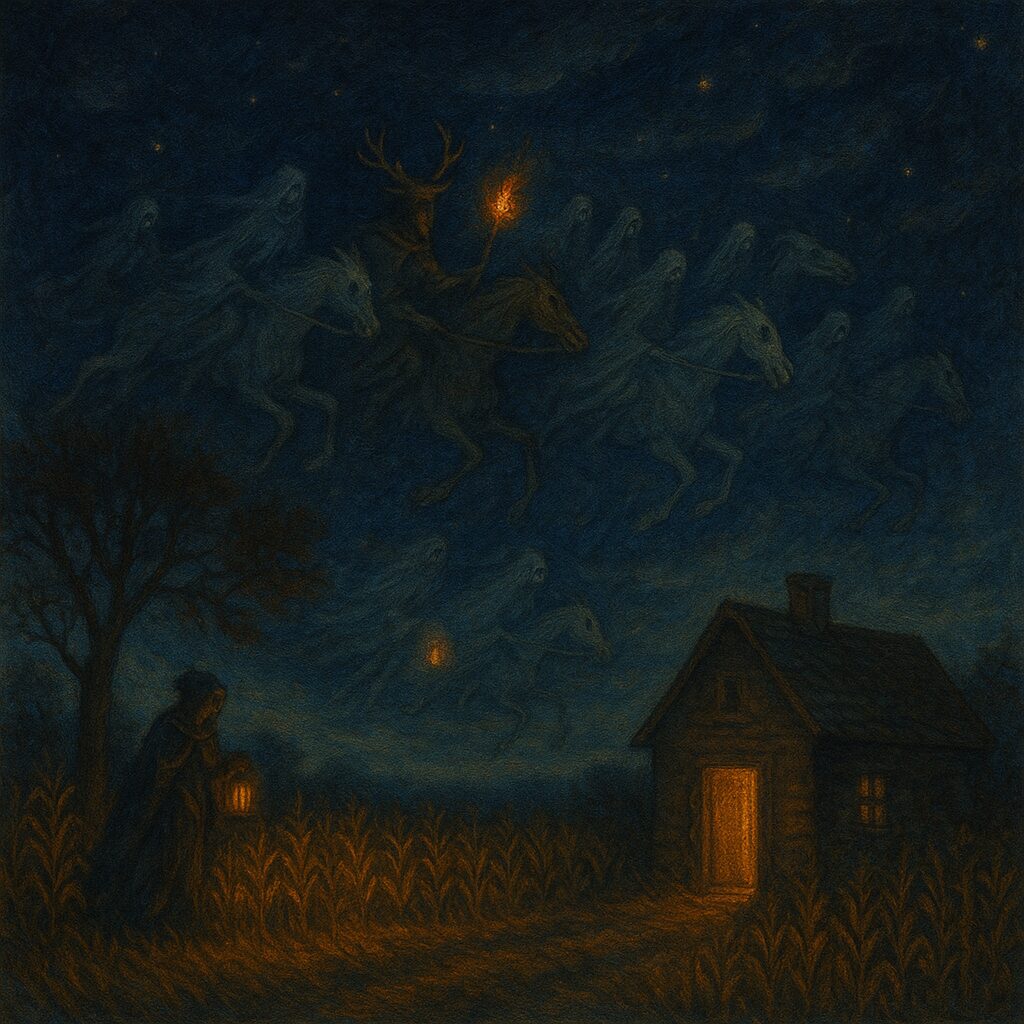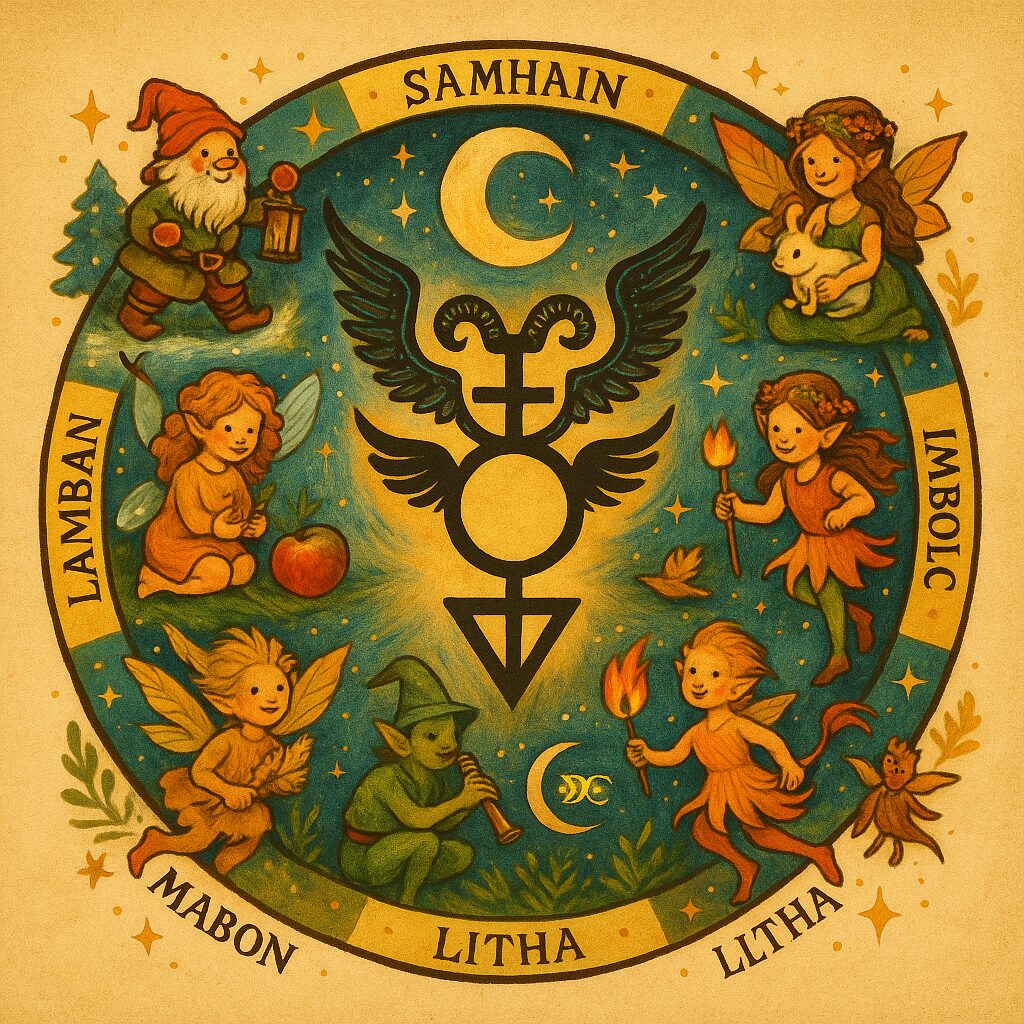The Wheel of the Year: A Journey Through the Eight Solar Sabbats
Once upon the turning of the world, before clocks ticked and calendars divided, the people listened to the land. They watched the stars, whispered with trees, and marked the year not by numbers, but by stories. These stories became the Solar Sabbats—eight sacred moments in the Earth’s turning, each one a threshold between light and dark, growth and decay, enchantment and return.
Witches today still walk that path, round and round the Wheel of the Year, where every Sabbat is not just a festival, but a doorway. Behind each lies lore—of gods and goddesses, of fae and field spirits, of firelight and feasting.
Let us walk that spiral, step by step, sabbat by sabbat, into a world where the veil thins and the magic lives.

Samhain (October 31 – November 1)
The Descent into the Otherworld
When the year tilts into shadow and the veil grows thin as smoke, the ancient gates of the Otherworld groan upon their hinges. The fields, once golden with grain, lie hushed beneath the hand of frost. The last fruits are gathered in, yet not all harvests belong to the living—for this is the night when the dead rise softly from their rest to walk beside us once more.
On this turning, the Fair Folk ride their spectral procession, the wild hunt coursing across the darkened sky. Hearth doors are left unlatched, lanterns burn low, and gifts of apple and milk are laid out, lest wandering spirits pass unfed. To neglect such reverence is to invite mischief, sickness, or sorrow upon the household.
Yet Samhain is not a festival of dread, but of holy remembrance. Through the mists comes the veiled Crone, her lantern raised against the dying year. She bids us to set a place at our table, not in fear of ghosts, but in love of kin—for the truth whispered in the stillness is this: we are never, ever alone.
And so, witches kindle a single black candle and a single white, calling to the ancestors in silence. An altar is dressed with mementos, with cider, or pomegranate laid as offering. Some keep vigil by the fire, scrying in flame or mirror for the faces of those who walked before. For in this smoky veil of Samhain, spellcraft is said to burn brightest—charms of protection, divination, and transformation carry the weight of the year’s ending, and the power of the unseen flows most freely.

Yule (Winter Solstice, ~December 21)
The Rebirth of the Sun Child
In the deep hush of winter, when the world is swaddled in snow and night, Yule arrives as a glimmering spark. Fires are lit on the longest night to beckon the Sun back into the sky.
Old folk tales spoke of elves and spirits who dwelled beneath the hills, only rising on Yule night to leave trinkets or tricks. The Yule Father rides the longest night, bearing gifts and secrets from the turning of the world as the white goddess’ vale shades the world in sleep.
Modern witches gather greens and burn the Yule log, inscribed with wishes. The sun god is reborn from the womb of the dark goddess, and even in sorrow, we dare to hope. It is a night for storytelling, for spells whispered under evergreen boughs, and for watching stars blaze over snow.
Imbolc (February 1–2)
The Hearth Awakens
Imbolc is the hush before the thaw. The lambing season begins, snowdrops push their faces through the frost, and the flame of the hearth burns bright. This is the sabbat of Brigid, she of the sacred well and poetic fire.
In Irish folklore, the Cailleach, the winter hag, gathers wood on Imbolc morning. If the weather is fair, she gathers much, prolonging winter. But if it storms, she sleeps in, and spring will come sooner.
Witches light white candles, sweep their altars, and ask Brigid to bless their homes and words. A Brigid’s cross woven from straw may be hung on doors, a folk talisman of protection. This is a sabbat of promise and purification—of kindling what sleeps.
Ostara (Spring Equinox, ~March 21)
Where Light Meets Dark in the Garden
On Ostara, the day and night stand as equals. The balance tips toward the light, and the earth exhales her first fragrant breath.
In the lands of the Saxons, the goddess Eostre was honored with hares and painted eggs—symbols of new life and fertility. Some say her companions were faeries who turned snowdrops into bluebells with a single kiss of dew.
Witches bless seeds and scribe intentions into the soil. Gardens become temples. Eggs are dyed with herbs, and sun water is sprinkled in doorways. It is a time for divination and dreaming, for asking what you would plant in your spirit.
Beltane (May 1)
The Fire Between Earth and Sky
Now the Maypole rises, wrapped in red and white. Beltane is the great wedding of land and sky, when lovers leap flames and the fae dance in the groves.
In Scottish tradition, cattle were driven between twin fires to purify them. People decorated their doors with hawthorn and danced all night under blooming trees. It was whispered that faeries walked freely, and mortals might vanish into their realms for a year and a day.
Modern witches gather for Maypole dances, light sacred fires, and speak blessings into the wind. It is the time of the Green Man and the Flower Queen, of sacred sexuality, joy, and embodiment.
Litha (Summer Solstice, ~June 21)
The Crown of the Sun
At Litha, the sun reaches its zenith. The Oak King is at his strongest—but also, on this day, begins to fade. The Holly King stirs in the shadows.
Old tales speak of fire fae and sun sprites, of herbs gathered at midnight retaining magical potency. In Slavic lore, people jumped through fires and searched for fern flowers, which bloomed only for the worthy.
Witches celebrate the longest day with rituals of strength, courage, and fulfillment. Honey is poured out to the bees, and golden talismans are blessed. It is a sabbat of joy and generosity—of light that feeds the soul.
Lammas / Lughnasadh (August 1)
Bread, Blessing, and the Sacrificed King
Lammas is the first harvest, when the Grain God dies to feed the people. In Celtic myth, Lugh, the bright one, hosted funeral games for his foster mother Tailtiu, who died clearing land for agriculture.
In folk tradition, the first sheaf of grain was braided into a corn dolly and placed on the hearth. Bakers made ritual loaves, and the fields rang with singing and the creak of scythes.
Witches honor this by baking with intention, offering bread to the earth, and naming what they are willing to surrender. This sabbat reminds us: sacrifice is sacred when done with love.
Mabon (Autumn Equinox, ~September 21)
Balance, Bounty, and the Turning Inward
Again the day and night are equal, but this time, we fall into dark. Mabon, though a modern name, echoes ancient rites of thanksgiving and reckoning.
In Welsh lore, Mabon ap Modron was stolen from his mother at birth and rescued from the underworld. He is the son of light returning from shadow, mirroring the harvest god’s descent.
Witches gather apples, whisper spells into windfallen leaves, and give thanks for what is and is not. Altars bloom with grapes, gourds, and grain. We stand in that bittersweet place between fullness and falling—and we bless both.
The Wheel’s Sacred Spiral
To turn the Wheel of the Year is to turn yourself—to spiral into your own becoming. Each sabbat is more than celebration. It is a myth enacted, a ritualized remembering that time is not a line but a dance of becoming and unbecoming.
These festivals are not relics. They are alive, whispered in wind, sung in shadow, flickering in flame. The fae still stir in the hedgerows. The gods still walk the barley. The witches still light their fires.
So Come.
Gather your herbs, your stories, your courage.
Step onto the path lit by fire and frost, by blossom and bone.
Let the Wheel turn you—not away from life, but into its sacred rhythm.

